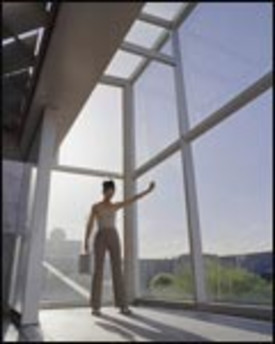Low-e coatings, which are microscopically thin layers of metallic oxide that’s bonded to the surface of a window’s glass, are so thin you can see right through them yet they prevent heat and ultra-violet (UV) rays from passing through glass. The result? A window with low-e glass does a better job keeping heat in during the winter and out during the summer.
Letting Light In
When you look outside on a sunny day, you’re seeing the visible part of the light spectrum. But only 38 percent of the solar energy that reaches the surface of the earth is visible. The rest of the light that lands in your yard is invisible. 59 percent is infrared and 3 percent is ultraviolet (UV rays). Even though they’re invisible, infrared and UV rays do affect the interior of your home. Infrared rays can pass in out out through glass windows, which increases your home’s heat load in the winter and cooling load in the summer. As for UV light, the same rays that burn your skin can enter through glazing to fade and degrade your fabrics and furnishings.
 |
|
|
The U-factor rating, and Solar Heat Gain Coefficient, Visible Transmission and Air Leakage numbers will help you decide if the window you want is suitable for your climate.
Credit: National Fenestration Rating Council
|
|
Coating Types
A low-e coating works like an invisible mirror to reflect selected portions of the light spectrum back out or back in through windows. There are three major types of coatings on the market: soft, hard, and Heat Mirror. Soft coat is applied to the surface of a finished piece of glass. It’s not durable enough to be exposed to the elements, so it’s only used on the inner surfaces of windows. Hard coat is not quite as energy efficient as soft coat, but is tough enough to be used on exposed surfaces. Hard coat is produced by fusing metallic oxide to the hot surface of glass during manufacture and is found primarily on storm windows and removable energy panels. Heat Mirror is a proprietary product that’s applied to a thin polyester sheet suspended between the two panes of dual pane window. The coating reflects radiant heat while the sheet decreases heat loss by splitting the air space in two.
Energy Ratings
To find out if the windows you’re considering are appropriate for the climate you live in, look at the Energy Star or National Fenestration Rating Council (NFRC) label. The NFRC label indicates the U-value and solar heat gain coefficient (SHGC) for that window. The Energy Star label shows how these ratings compare to the minimum energy-efficiency standards of the U.S. Department of Energy (DOE). Energy Star breaks the country into 3 zones. To meet the standards, windows used in areas like Florida and Southern Texas must have a SHGC rating of .40 or lower and a U-factor of .75 or lower. In states like Maine and Montana, the DOE says windows should have a U-factor of .35 or less but has no requirement concerning solar heat gain. That’s because in the far North heat loss is a big issue but solar heat gain isn’t.
The NFRC label also contains information on visible light transmission (VLT), which can be reduced by some coatings. The VLT rating indicates the percent of visible light able to pass through the glazing. Since the whole idea of using glass windows is to admit light, look for a VLT rating of .60 to .80 (60 to 80 percent). On the plus side, low-e coatings do block some of the UV light that can fade and damage furniture. These ratings don’t show up on the NFRC label, but can often be obtained from the window manufacturer.
Cold Climates
 |
||||
|
||||
Low-e coatings were introduced in the 1980’s, and were devised to save energy in cold climates. Early low-e windows were designed to let light and solar heat pass through the glazing into the building, and to reflect heat back into the building when it tried to escape through the glass. By lowering the U-value or heat loss rating of the glazing, a low-e coating reduces the amount of energy needed to heat the building. Sitting next to a window when it’s cold becomes much more comfortable because the heat that radiates from your body is reflected back into the house. What’s more, the glass stays warmer, so moisture is a lot less likely to condense on the inside of the window.
Hot Climates
The problem with windows designed for cold climates is that they keep heat in but they don’t keep it out. As a result, early low-e windows weren’t much help in the South, where it’s harder to stay cool than it is to stay warm. In the 1990’s, manufacturers introduced windows with spectrally selective coatings. Designed for use in hot climates, windows with these coatings admit up to 40 percent less solar heat than ones with clear glass panes. As a result, less heat enters through the glass, so the house is easier to cool.
Credit: Renovate Your World




























